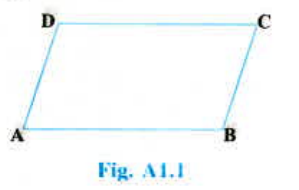Given that ABCD is a parallelogram, and suppose AD = 5 cm, AB = 7 cm (see Fig. A1.1). What can you conclude about the lengths of DC and
BC?
 Solution in Punjabi
Solution in Punjabi
Step by step video & image solution for Given that ABCD is a parallelogram, and suppose AD = 5 cm, AB = 7 cm (see Fig. A1.1). What can you conclude about the lengths of DC and BC? by Maths experts to help you in doubts & scoring excellent marks in Class 10 exams.
Topper's Solved these Questions
Similar Questions
State whether the following statement is always true, always false or ambiguous. Justify your answer. The Sun orbits the Earth.
02:11View SolutionFind the probability of getting a head when a coin is tossed once. Also find the probability of getting a tail.
01:31View SolutionCheck whether the following are quadratic equations: (x+1)2=2(x−3)
02:46View SolutionDetermine the point of symmetry of a regular hexagon.
03:53View SolutionDtermine the images of the following figure about the given line :
02:45View SolutionIn the figure above (not to scale), ¯¯¯¯¯¯AB⊥¯¯¯¯¯¯CDandAD is the bisector of ∠BAE.AB=3cm and AC=5cm. Find CD.
02:17View SolutionFind the area of the shaded region, given that the radius of each circle is equal to 5 cm.
05:41View SolutionMatch the following Column A to Column B
 02:21View Solution
02:21View SolutionMatch the following Column A to Column B
 02:03View Solution
02:03View SolutionMatch the following Column A to Column B
 02:10View Solution
02:10View SolutionFind the area of the figure given below.
 02:17View Solution
02:17View SolutionThe area of the shaded part in the figure given below is ______.
 02:10View Solution
02:10View SolutionThe inequation represented by the graph given below is :
04:23View SolutionThe inequation that best describes the graph given below is _________
01:13View SolutionThe inequation that best describes the following graph is _________
01:23View SolutionWhich inequations represent the shaded region in the given figure
03:10View Solution

